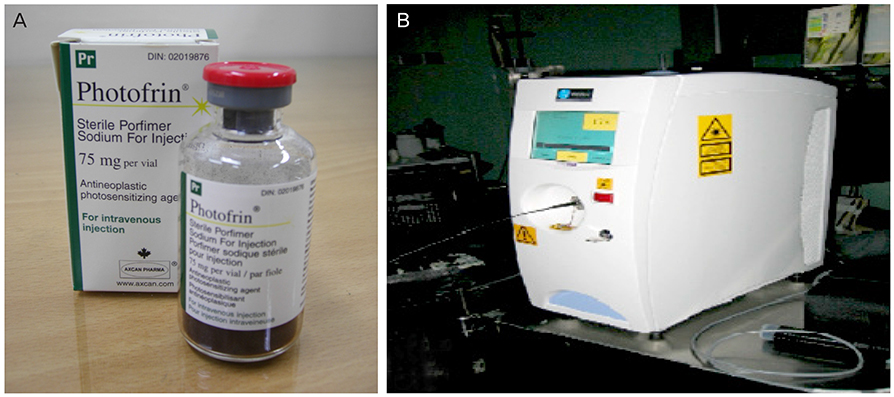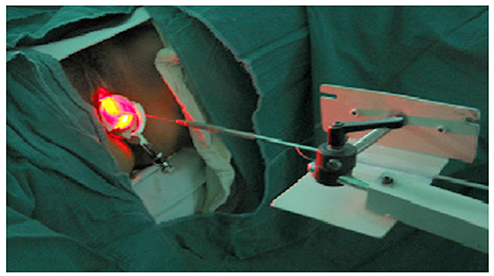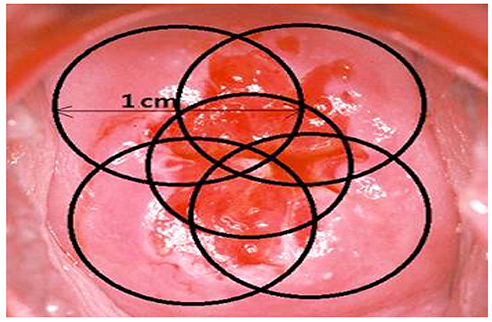Obstet Gynecol Sci.
2016 Nov;59(6):479-488. 10.5468/ogs.2016.59.6.479.
Clinical efficacy of photodynamic therapy
- Affiliations
-
- 1Department of Obstetrics and Gynecology, Dankook University College of Medicine, Cheonan, Korea. pch10@dankook.ac.kr
- KMID: 2378572
- DOI: http://doi.org/10.5468/ogs.2016.59.6.479
Abstract
OBJECTIVE
The management of cervical intraepithelial neoplasia (CIN) and early invasive cancer of the uterine cervix is very difficult to approach, especially in case of young woman who wants to preserve her fertility. Conization of the cervix may have various kinds of disadvantage. The objective of this clinical retrospective study is to investigate the therapeutic effects and clinical efficacy of photodynamic therapy (PDT) including combined chemo-photodynamic therapy in patients with pre-malignant CIN and malignant invasive cervical cancer.
METHODS
Total number of PDT trial case was 50 cases and total number of patient was 22 patients who registered to PDT clinic. We used photogem sensitizer and 632 nm diode laser in early two cases. After then we performed PDT using photofrin sensitizer and 630 nm diode laser in other cases. We used flat-cut, microlens, cylindrical diffuser, and interstitial type optic fibers in order to irradiate the lesions. 240 J/cm² energy was irradiated to the lesions.
RESULTS
CIN 2 were 4 cases (18.2%) and CIN 3 were 15 (68.2%) and invasive cervical cancer were 3 (13.6%). Complete remission (CR) was found in 20 patients (91%). One case of 19 patients with CIN lesion recurred at 18 months after PDT treatment. CR was found in 18 cases in the patients with CIN lesions (95%). CR was found in 2 cases in the patients with invasive cervical cancer (67%).
CONCLUSION
Our data showed that CR rate was fantastic in CIN group (95%). This study suggests that PDT can be recommended as new optimistic management modality on the patients with pre-malignant CIN lesions including carcinoma in situ and relatively early invasive cancer of the uterine cervix. Combined chemo-photodynamic therapy is essential in case of invasive cervical cancer. For the young age group who desperately want to preserve their fertility and have a healthy baby, PDT can be a beacon of hope.
Keyword
MeSH Terms
Figure
Reference
-
1. International Agency for Research on Cancer. World cancer report 2014 [Internet]. Lyon: International Agency for Research on Cancer;cited 2016 Sep 20. Available from: http://publications.iarc.fr/Non-Series-Publications/World-Cancer-Reports/World-Cancer-Report-2014.2. Park CH. Photodynamic therapy in uterine cervix cancer. Dankook Med J. 2009; 10:39–47.3. Ackroyd R, Kelty C, Brown N, Reed M. The history of photodetection and photodynamic therapy. Photochem Photobiol. 2001; 74:656–669.4. Park CH. Gynecological cancer and photodynamic therapy. J Korean Photodyn Assoc. 2007; 4:10–18.5. Park CH, Park JW, Kwon MS, Ahn JC, Chung PS, Rhee CK, et al. A case of squamous cell carcinoma in situ of the uterine cervix cured by photodynamic therapy. Shanghai Laser Medical Association of Chinese Medical Association. In : Proceedings of the 11th World Congress of the International Photodynamic Association; 2007 March 28-31; Shanghai, China. Beijing: Chinese Medical Association;2007. p. 158.6. Allison RR, Cuenca R, Downie GH, Randall ME, Bagnato VS, Sibata CH. PD/PDT for gynecological disease: a clinical review. Photodiagnosis Photodyn Ther. 2005; 2:51–63.7. Cho HC, Park CH. The anticancer effect of photodynamic therapy using ALA and 632 nm diode laser on cervical cancer [dissertation]. Cheonan: Dankook University;2006.8. Choi MC, Jung SG, Park H, Lee SY, Lee C, Hwang YY, et al. Fertility preservation by photodynamic therapy combined with conization in young patients with early stage cervical cancer: a pilot study. Photodiagnosis Photodyn Ther. 2014; 11:420–425.9. Kim JS, Chung PS. The antitumor effect and mechanism of photodynamic therapy using 9-hydropheophorbide-a and 670 nm diode laser on HT-3 cervical cancer cell [dissertation]. Cheonan: Dankook University;2006.10. Eisenhauer EA, Therasse P, Bogaerts J, Schwartz LH, Sargent D, Ford R, et al. New response evaluation criteria in solid tumours: revised RECIST guideline (version 1.1). Eur J Cancer. 2009; 45:228–247.11. Park CH. Photodynamic therapy using photofrin 630 nm PDT laser in woman with recurrent squamous cell carcinoma in situ of the uterine cervix. J Korean Photodyn Assoc. 2007; 4:163–170.12. Tao XH, Guan Y, Shao D, Xue W, Ye FS, Wang M, et al. Efficacy and safety of photodynamic therapy for cervical intraepithelial neoplasia: a systemic review. Photodiagnosis Photodyn Ther. 2014; 11:104–112.13. Hopper C. Photodynamic therapy: a clinical reality in the treatment of cancer. Lancet Oncol. 2000; 1:212–219.14. Huang Z. A review of progress in clinical photodynamic therapy. Technol Cancer Res Treat. 2005; 4:283–293.15. PDT Korea. Handbook of clinical photodynamic therapy. 2nd ed. Seoul: PDT Research Center;2001.16. Korean Photodynamic Therapy Association. Photodynamic therapy. Seoul: Korea Medicine;2007.17. Brown SB, Brown EA, Walker I. The present and future role of photodynamic therapy in cancer treatment. Lancet Oncol. 2004; 5:497–508.18. Muroya T, Kawasaki K, Suehiro Y, Kunugi T, Umayahara K, Akiya T, et al. Application of PDT for uterine cervical cancer. Diagn Ther Endosc. 1999; 5:183–190.19. Lee C, Kim J, Jeong CH, Na YJ, Kim IH, Lee SY, et al. Photodynamic therapy in the management of cervical intraepithelial neoplasia. Korean J Gynecol Oncol Colposc. 2004; 15:85–91.20. Han SJ, Song CH, An TK, Lee BR, An YS. The effect of photodynamic therapy on HSIL with hematoporphyrin (HpD), especially in young women. J Korean Photodyn Assoc. 2004; 1:101–107.21. Yamaguchi S, Tsuda H, Takemori M, Nakata S, Nishimura S, Kawamura N, et al. Photodynamic therapy for cervical intraepithelial neoplasia. Oncology. 2005; 69:110–116.22. Di Saia PJ, Creasman WT. Preinvasive disease of the cervix. In : Di Saia PJ, Creasman WT, editors. Clinical gynecological oncology. 4th ed. St. Louis (MO): Mosby Year Book;1992. p. 1–36.23. Park CH, Kim JK. Detection of human papillomavirus type 16 and 18 by PCR in patients with cervical neoplasia. Korean J Obstet Gynecol. 2010; 53:894–904.24. Park CH. Cervical cytology. 1st ed. Cheonan: Hanyoung;2004. p. 61–96.25. Park CH. False-negative results of conventional Papanicolaou cervical cytology in women with cervical conization. Korean J Gynecol Oncol. 2008; 19:40–47.26. Yao H, Zhang Y, Xiao F, Xia Z, Rao J. Quantum dot/bioluminescence resonance energy transfer based highly sensitive detection of proteases. Angew Chem Int Ed Engl. 2007; 46:4346–4349.27. Kines R, Cuburu N, Kobayashi H, MacDougall J, de los Pinos E, Schiller J. HPV based photodynamic therapy: a new approach for anti-cancer therapy (VAC12P.1019). J Immunol. 2014; 192:1 Supplement. 206.8.28. Kim J, Tung CH, Choi Y. Smart dual-functional warhead for folate receptor-specific activatable imaging and photodynamic therapy. Chem Commun (Camb). 2014; 50:10600–10603.
- Full Text Links
- Actions
-
Cited
- CITED
-
- Close
- Share
- Similar articles
-
- Comparing palliative treatment options for cholangiocarcinoma: photodynamic therapy vs. radiofrequency ablation
- Photodynamic Therapy Combined with 1064-nm Nd:YAG Laser Therapy and Topical Efinaconazole for Refractory Onychomycosis: Case Series
- Photodynamic Therapy for Esophageal Cancer
- Photodynamic Therapy (PDT): PDT Mechanisms
- Photodynamic Therapy of Choroidal Neovasculariation Associated with Large Serous Pigment Epithelial Detachment






